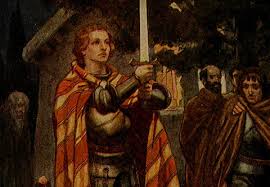Introduction
Storytelling is a vital factor of information transfer and storytelling throughout history. Tales of knights and chivalry intertwined with magic and mystery became cautionary and moral lessons. Truths and societal ideals were also revealed through the fairy tales which ensured the preservation of medieval culture throughout history. According to research there are various categories of fairy tales. There are canonical ( obscure) tales, ornate orally -collected tales, and differing versions of translated tales. They can be used as valuable tools within classrooms to teach historical context, language and culture.
Historically, information was first shared through oral tradition. Changes and miscommunication could occur due to differences in perspective and missing or forgotten pieces of stories. Once people began writing down tales, it became easier to relay information and stories to people near and far. Eventually, life lessons were adapted into versions which children could understand. Written versions of the tales passed on through generations and transformed into the modern fairy tales children know today.
Defining Myth and Magic
Defining these terms is important to understanding the significance of fairy tales’ transformation over time and how phenomena became important to modern culture. Unexplained elements such as magic and mythical creatures explained unnatural occurrences and emphasized society’s ideals in the past and present.
What is…
A Myth – A traditional story explaining social or natural phenomenon
Magic- Mysterious or unnatural forces e.g wizards or witches
Fairy Tale – A story which involves imaginary beings and lands
Folklore– Traditions, beliefs and customs passed on through oral tradition
Royalty, Knights, and King Arthur

Art, Suzanne , lesson plan Tales of King Arthur.
Fairy tales usually mention or take place within kingdoms. Kingdoms tend to consist of kings,queens,princesses,princes and knights. One or all of these people usually tend to interact with one another as a unit in tales and folklore. For example, the story of King Arthur involves all those charters and then some. Why focus on King Arthur specifically? King Arthur is a well-know folklore king, and tales of his reign have been passed through oral tradition and literature. His stories glorify his rule and consistently revere acts of bravery and chivalry. In various versions of the tale, Arthur fails to be a strong romantic lead but he succeeds time and time again politically and in times of adversity. The popularity of the tale waned after the medieval period. But its prestige became present again in the modern era through media such as book series, TV shows and movies.
Wizards and Witches

Witches and wizards appear fairy tales frequently. They are either villains or companions in dangerous quests or magical mysteries. Witches and wizards developed a reputation in the real world as being dangerous,but fictional and mysterious beings in literature continued to be popular in fairy tales. Merlin is an example of a prominent magical presence throughout Arthurian legends.
In some versions of the story of Merlin he serves as a mentor to Arthur from the second he is born until he becomes king. In other versions, he does not directly cross paths with Arthur but is indirectly connected to him through other characters. Merlin aids other royals in other tales and guides them in decision-making. This is significant because it reveals the importance of magic and mystery having influence over powerful leaders and the course history took or did not take based off of a magical being’s advice or wisdom.
References
Davidheiser, James C. 2007. “Fairy Tales and Foreign Languages: Ever the Twain Shall Meet.” Foreign Language Annals 40 (2): 215-225.
Jorgensen, Jeana. 2014. “Marvelous Transformations: An Anthology of Fairy Tales and Contemporary Critical Perspectives/The Teller’s Tale: Lives of the Classic Fairy Tale Writers.” Journal of American Folklore 127 (506)
Zipes, Jack. 2019. “Speaking the Truth with Folk and Fairy Tales: The Power of the Powerless.” Journal of American Folklore 132 (525)
